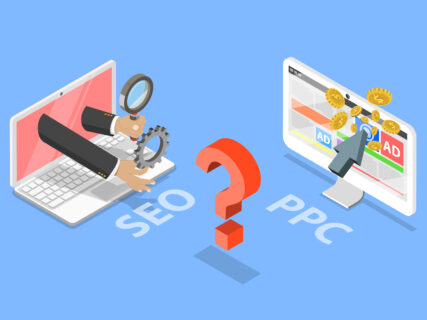
10 mins
OpenSEO vs PPC: The pros, cons, and how they can complement each other in a search campaign
6 mins
Search traffic has become vital to any business with a website (which should by now be all of them!). However, while search traffic is important, so is getting the right kind of search traffic.
1st September 2016

An increase in search traffic tends to be an important indicator of a successful SEO campaign.
Search traffic has become vital to any business with a website (which should really be all of them!)
Employing an effective search engine optimisation strategy is a great way to generate more search traffic to your business’s website. But is an increase in search traffic always the result of SEO, and is a large amount of search traffic always good for your website?
In the bustling realm of online casinos, attracting players to your website is akin to luring guests to a grand casino floor. The digital landscape is competitive, and enhancing your casino website’s search traffic requires a strategic approach that combines innovation and effective marketing tactics.
So, how can you increase search traffic to your casino website? The path to success lies in a multifaceted approach that harnesses the power of search engine optimization (SEO) and user engagement.
1. Quality Content: Crafting engaging and informative content relevant to casino gaming, strategies, and tips can captivate players’ interest and establish your website as a valuable resource. Regularly updated blogs and articles can attract organic traffic and keep visitors coming back for more.
2. SEO Optimization: Employing targeted keywords, optimizing meta descriptions, and ensuring mobile-friendliness are essential SEO practices that improve your website’s visibility on search engines. This enhances the chances of your casino website appearing in relevant search results.
3. Backlink Building: Cultivate relationships with reputable casino-related websites and seek opportunities for backlinks. High-quality backlinks from authoritative sources can boost your website’s credibility and search ranking.
4. Social Media Engagement: Leverage the power of social media platforms to engage with your audience and promote your casino website. Share compelling content, interact with users, and foster a community of players who are excited to visit your site.
5. Utilize Analytics: Regularly analyze your website’s traffic and user behavior using tools like Google Analytics. This insight can help you refine your strategies, optimize content, and tailor your efforts to your audience’s preferences.
6. Pay-Per-Click (PPC) Advertising: Strategic use of PPC advertising can drive targeted traffic to your casino website. Platforms like Google Ads allow you to create ads that appear at the top of relevant search results, increasing your website’s visibility.
7. Mobile Optimization: In an era where mobile devices dominate internet usage, ensuring your casino website is mobile-responsive is crucial. A seamless mobile experience can lead to higher search rankings and better user engagement.
8. Engaging Design: An attractive and user-friendly website design can entice visitors to explore your offerings further. A visually appealing layout and intuitive navigation can contribute to longer visit durations and reduced bounce rates.
Increasing search traffic to your casino website demands a combination of technical expertise, creativity, and a deep understanding of player preferences. As the digital landscape evolves, applying these strategies can position your website as a beacon for casino enthusiasts seeking entertainment, knowledge, and the thrill of gaming.
By employing these tactics, casino operators can navigate the dynamic online space and create a digital destination that resonates with players, ultimately driving increased search traffic and contributing to a successful online casino venture.
Search traffic is a term used to describe the number of visitors to your company’s website after conducting a search for your product, service or brand on a search engine (in the UK this will mostly be Google).
Therefore an increase in search traffic tends to be an important indicator of a successful SEO campaign.
The higher your SEO campaign can get you to rank in Google, the greater your search traffic is likely to be. And the greater your search traffic, the more people (it stands to reason) will want to purchase your products/services.
Other sources of traffic include paid traffic, direct traffic and referral traffic.
Paid traffic is the result of any online advertisements which your company purchased outright. These can include Google’s pay per click (PPC) ads and banners on 3rd party sites
Direct traffic comprises visits to your site which did not come via a search engine. In other words, a user will have typed the URL directly into the address bar or had a bookmark to your site which they clicked. These users would have already heard of your business and likely know what it does.
Referral traffic is any visit via a link on other sites that takes visitors directly to your site without them having to search for it.
What SEO campaigns are really good at doing is increasing non-branded traffic.
Search traffic, or organic traffic as it is often referred to, is a collective term for all users who are led to your site through search engine results and general web browsing.
When an SEO campaign improves your rankings in Google, it is your website’s organic traffic which should see an improvement. But this traffic can again be broken down into two distinct groups: branded and non-branded traffic.
Branded traffic is the result of users searching for your brand by name. Since your brand will already rank first in Google for branded search, SEO campaigns won’t need to devote much energy to your company’s branded keywords. The is is like a shopper going to a store and asking for a “Dyson Airblade”.
What SEO campaigns are really good at doing is increasing non-branded traffic. This comprises visits based on keywords that describe your products or services. In other words, this may be the visitor’s first encounter with your site. In this case the real world equivalent is a shopper asking for “a good fan” and the shopkeeper suggesting a number of options.
In the case of non-brand traffic it is the SEO campaign, through achieving visibility in non-branded search, that is marketing your service or product and driving traffic to it.
When a site receives a sudden influx in branded traffic this will reflect as organic traffic but may not necessarily be the exclusive result of SEO.
Since branded traffic relies on an existing familiarity with the brand, it is more likely to be a combination of other (offline) marketing activity or press coverage and some technical optimisation that allows a site to be visible in a branded query.
Google’s Analytics console doesn’t distinguish between branded and non-branded traffic. This makes it difficult to get granular data on the kind of organic traffic you are receiving.
However, using Google’s Search Console it is possible to get a basic sense of the volume of brand-specific search your site is attracting. If you have access to your site’s Search Console, navigate to the Analytics View where you will get a breakdown of the popular search terms your site is ranking for, which position it ranks in and how many clicks your site has attracted.
At Go Up we use software that lets us track traffic from specific keywords thus allowing us to report separately on branded and non-branded visitors.
Often it makes more sense for an SEO campaign to target smaller traffic volumes.
As would have become apparent in this article, not all traffic is the same.
Often it makes more sense for an SEO campaign to target smaller traffic volumes but in so doing to attract visitors who are truly looking for your service.
Attracting irrelevant traffic to your site can drive up your site’s bounce rate (the percentage of people who view your site and leave it quickly).
Though Google insists it does not take high bounce rates into account as a ranking factor, because it indicates poor user experience, it’s a good idea to try to keep bounce rates low, particularly on pages where you would normally expect users to dwell or to click on to a further link in the site (like on a product page where ideally the next click is “add to cart”). Bounce rates may be higher on contact pages where users get a phone number and leave immediately.
A high bounce rate can be an indicator that users haven’t found your website useful and there is strong evidence to suggest that there are at least correlations between a high bounce rate and reduced rankings.
This is why it’s important to know where your traffic is coming from and pursue quality visits at all times.
Someone working on an SEO campaign for your site will need to monitor your keywords and make sure they don’t give potential visitors to your sight the wrong idea of what your business does. Being visible for high volume keywords might well result in high search traffic, but it probably won’t always lead to a proportionate amount of conversions.
Even though search traffic isn’t always the result of SEO, a properly executed SEO strategy will drive a marked increase in quality organic traffic with a strong potential for conversion (making a sale). Because SEO campaigns tend to target non-branded organic traffic, they remain vitally important marketing tools.